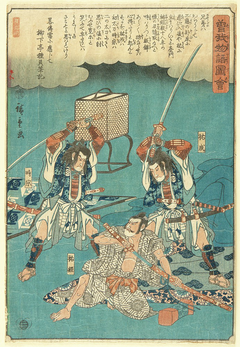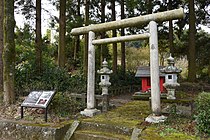Revenge of the Soga Brothers
 Soga brothers killing Kudō Suketsune by Utagawa Hiroshige | |
| Native name | 曾我兄弟の仇討ち |
|---|---|
| English name | Revenge of the Soga Brothers |
| Date | June 28, 1193 |
| Venue | Fuji no Makigari |
| Location | Kamino, Fujino, Shizuoka Prefecture |
| Type | Revenge attack, assassination attempt |
| Cause | Murder of Kawazu Sukeyasu |
| Target | Kudō Suketsune and Minamoto no Yoritomo |
| Patron(s) | Hōjō Tokimasa |
| Organised by | The Soga brothers (Soga Sukenari and Tokimune) |
| Participants | 2 |
| Outcome | Revenge successful |
| Casualties | |
| Soga brothers: 1 | |
| Kamakura shogunate: 14+ | |
| Deaths | 15+ |
| Non-fatal injuries | 9 |
| Arrests | Soga Tokimune apprehended by Gosho no Gorōmaru |
| Accused | Soga brothers |
| Sentence | Soga Tokimune sentenced to death |
The Revenge of the Soga Brothers (曾我兄弟の仇討ち, Soga kyōdai no adauchi) was a vengeance incident on June 28, 1193, during the Fuji no Makigari hunting event arranged by shogun Minamoto no Yoritomo. The Soga brothers, Soga Sukenari and Tokimune assassinated Kudō Suketsune, the killer of their biological father. The incident included a failed assassination attempt on the shogun, and resulted in several deaths and injuries of unrelated participants. It is known as one of the three major adauchi vendetta incidents in Japan, alongside Akō vendetta (by the 47 Rōnin) and the Igagoe vendetta.[1]
Story[]
Background[]
Kudō Suketsune had a grudge against Itō Sukechika (his former father-in-law) for taking his land and disrupting his marriage. Sukechika had been dissatisfied with the laws of inheritance and the division of land, and was able to take over Suketsune's land by forcing his daughter, Mangō-Gozen, to divorce Suketsune.
In October 1176, Suketsune led a small group and ambushed Sukechika while he was hunting. However, Suketsune's two accomplices accidentally hit Kawazu Sukeyasu, the son of Sukechika who was with him, and Sukeyasu died. The two assassins were killed by Sukechika shortly after the failed assassination attempt.[2] Sukeyasu's widow, Mitsue Gozen, married Soga Sukenobu. Sukeyasu's two sons grew up in Soga no Sato, and thus became known as the Soga Brothers.[3] The brothers are said to have mourned for their late father.[2]
Sukechika, who sided with Taira clan, committed suicide after the loss of the Genpei War in 1185. On the other hand, Suketsune quickly became a gokenin (vassal) of shogun Minamoto no Yoritomo.[2]
The Soga brothers, grandsons of Sukechika, had a difficult upbringing, and the elder brother Sukenari took over the Soga family.[2] The younger brother Tokimune hated priesthood and escaped from Hakone, relying on his uncle by marriage, Hōjō Tokimasa, whose late wife was the daughter of Sukechika. Tokimasa would be the greatest supporter of the Soga brothers in the midst of their hardships, and the Soga brothers never forgot their father's vengeance.[2]
Revenge[]

In June 1193, shogun Minamoto no Yoritomo held a grand hunting event, called the Fuji no Makigari, at the foot of Mount Fuji. The Soga brothers, along with their enemy Suketsune, participated in the event.
On June 28, 1193, the last night of the Fuji no Makigari, the participants were staying in Kamino, Fujino (in present-day Kamiide, Fujinomiya, Shizuoka Prefecture). The Soga brothers entered Kamino no Goryokan, where Suketsune was staying, and killed Suketsune fulfilling their vow. Ōtōnai, who was drinking sake with Suketsune was also killed by the brothers. Two prostitutes, Tengo-no-Shuku and Kisegawa-no-Shuku, who were accompanying Suketsune, started screaming causing a big uproar at the scene. After the brothers killed Uda Gorō and nine other participants injuring Tairako Arinaga, , Kikkawa Tomokane, Katō Mitsukazu, , Okabe Yasaburō, Okabe Kiyomasu, Hori Fujita and Usuki Hachirō at the scene, the elder brother Sukenari was shot by Suketsune's subordinate Nitta Tadatsune. The younger brother Tokimune killed all the samurai one by one who attempted to stop him, and raided Yoritomo's living quarters. However, Gosho no Gorōmaru, who was in Yoritomo's bedchamber, took Tokimune down and captured him, thus ending the massacre and saving the shogun from a possible assassination attempt.[2][4]
After the turmoil had settled, Wada Yoshimori and Kajiwara Kagetoki conducted inquest on the dead. Tokimune was taken in for questioning by Yoritomo about the motives of the massacre. At first Yoritomo considered sparing Tokimune's life, but had him executed the next day at the request of Suketsune's son, .[2][4]
Interpretations[]
Hōjō Tokimasa Mastermind Theory[]
Hiroyuki Miura advocated the Hōjō Tokimasa Mastermind Theory in the Taishō era, which has had a great influence on the academia ever since.[5][6][7] In Azuma Kagami and Soga Monogatari, after killing Suketsune, Tokimune also attempted to attack shogun Minamoto no Yoritomo, which is interpreted as a result of Tokimasa's secret maneuvers. Tokimasa had entered Suruga Province in advance as a preparation for his secret plan,[8] and even when Yoritomo arrived at Fujino, he had visited Fujino in advance, which has brought convinction to this theory. Furthermore, before that, the Soga brothers had a strong relationship with Tokimasa.[9] Tokimune had also had his coming-of-age ceremony (genpuku) at Tokimasa's mansion with Tokimasa as his guardian (eboshi-oya), Tokimasa bestowing the kanji "toki" (時) in his name upon Tokimune.[10] Many still debate that Tokimasa, who had been acquainted with the Soga brothers, led Tokimune to attack Yoritomo.[9]
Minamoto no Yoritomo Revenge Theory[]
In addition, Itō Sukechika had killed Yoritomo's eldest son, Chizuru Maru (Chizuru Gozen), just before being attacked by Kudō Suketsune. There is also a theory that the Soga brothers knew that Yoritomo was behind the attack on Sukechika.[11]
Aftermath[]
After the incident, Sukenari's mistress and a prostitute, Tora, mourned at the mansion of Ide in Fujino, the site of the revenge and the site where Sukenari died.[12] A shrine was later erected in that place.[13][14]
From the issue relating the samurai of the Hitachi Province that fled without defending Yoritomo during this incident, and the fact that Take Yoshimoto of the Hitachi Province unfurled the standard of revolt shortly after the incident, there is a theory that this deepened Minamoto no Yoritomo's suspicion towards his general, Minamoto no Noriyori.
There is also a theory that Minamoto no Noriyori, a half-brother of Yoritomo, did not participate in the Fuji no Makigari, and that it was related to the later exile of Noriyori.
Soga Monogatari[]
The Revenge of the Soga Brothers was later summarized in Soga Monogatari. In the Edo period, the Revenge of the Soga Brothers became a popular subject in noh, kabuki,[15] and ukiyo-e.
There is a group of works called "Sogamono" in noh, which are based on the Revenge of the Soga Brothers. The earliest example of a Sogamono performance is recorded in Kanmon Nikki, and is called "Soga Gorō Genpuku", and was performed on March 14, 1432.[16]
From around the Enpō era (1673-1681), new Sogamono kabuki was born one after another, and it was especially popular in the 18th century. In Edo, it became a custom to perform a new Sogamono in the New Year, which continued until the Meiji era.[17]
In popular culture[]
Literature[]
- Soga Kyōdai no Mitsumei - Tennō no Shikaku (曾我兄弟の密命―天皇の刺客) by Naoki Takahashi (Bungeishunju)
Filmography[]
- Soga Kyōdai Kariba no Akebono (曾我兄弟狩場の曙) (1908) M. Pathe, Shōkichi Umeya
- Soga Jyubankiri (曾我十番斬) (1916)
- Eiroku Soga-tan (永禄曾我譚) (1917) Kobayashi
- Kosode Soga (小袖曽我) (1920)
- Youchi Soga (夜討曽我) (1923) Teikoku Kinema
- Soga (曽我) (1927)
- Nikkatsu Kōshinkyoku Soga Kyōdai (日活行進曲 曽我兄弟) (1929)
- Youchi Soga (夜討曽我) (1923) Makino Film Productions
- Adauchi Nihon Hare Takashi no Maki Soga Kyōdai (仇討日本晴 孝の巻 曾我兄弟) (1931) Teikoku Kinema
- Fuji no Akebono Shōnen Soga (富士の曙 少年曾我) (1940)
- Soga Kyōdai Fuji no Yashū (曽我兄弟 富士の夜襲) (1956) Toei, Yasushi Sasaki
TV series[]
- Soga Kyōdai (曾我兄弟) (1959) Nippon TV
- Kusa Moeru (草燃える) (1979) NHK Taiga drama
Manga[]
- Yumegatari Series: Amakakeru Hoshi (夢語りシリーズ 天翔ける星) by Seiko Yuguchi (Akita Shoten)
Music[]
- Haruo Minami - "Chōhen Kayō Rōkyoku Soga no Uchiiri"
Musicals[]
- Tōken Ranbu - Higekiri Hizamaru Sōki Shutsujin ~SOGA~ by Tōken Ranbu
Gallery[]

Moor at the Foot of Mt Fuji- Soga Brothers Achieving their Avowed Wish by Utagawa Kuniyoshi

The Soga brothers' grave at Soga Hachimangu Shrine, in Kamiide, Fujinomiya, Shizuoka Prefecture

Kudō Suketsune's grave in Kamiide, Fujinomiya, Shizuoka Prefecture
See also[]
References[]
- ^ Ono (2004). Jinbutsudenkojiten Kodai・Chuseihen (人物伝小辞典 古代・中世編). Japan: Tokyodo Shuppan. p. 186. ISBN 4490106467.
- ^ a b c d e f g Ichiko, Teiji (1966). Soga Monogatari - Iwanami Koten Bungakutaikei 88 (曽我物語 岩波古典文学大系88). Japan: Iwanami Shoten.
- ^ Aoki, Akira (1987). Manabon Soga Monogatari 1 (真名本曾我物語 1). Japan: Heibonsha. p. 253. ISBN 9784582804683.
- ^ a b Sakai, Koichi (2000). Soga Monogatari no shijitsu to kyokou (曽我物語の史実と虛構). Japan: Yoshikawa Koubunkan. pp. 117–118. ISBN 4-642-05507-X. OCLC 675757532.
- ^ Miura, Hiroyuki (1915). Rekishi to Jinbutsu: Soga Kyōdai to Hōjō Tokimasa (曾我兄弟と北条時政 歴史と人物). Iwanami Shoten.
- ^ Ishii, Susumu (1974). Chusei Bushidan: Soga Monogatari no Sekai (曾我物語の世界 中世武士団). Kodansha.
- ^ Koichi, Sakai (2014). Soga Monogatari no Shiteki Kenkyu (曽我物語の史的研究). Yoshikawa Kobunkan. pp. 11–12. ISBN 978-4-6420-2921-6.
- ^ Sakai, Koichi (2014). Soga Monogatari no Shiteki Kenkyu (曽我物語の史的研究). Yoshikawa Kobunkan. p. 120. ISBN 978-4-6420-2921-6.
- ^ a b Sakai, Koichi (2014). Soga Monogatari no Shiteki Kenkyu (曽我物語の史的研究). Yoshikawa Kobunkan. pp. 140–160. ISBN 978-4-6420-2921-6.
- ^ Azuma Kagami (吾妻鏡). 1266. First year of Kenkyū, ninth month, seventh day (建久元年(1190年)9月7日条).
- ^ Hotate, Michihisa (2015). Chūsei no kokudo kōken to tennō, buke. Azekura Shobo. ISBN 978-4-7517-4640-0. OCLC 919393328.
- ^ Nihonmatsu, Yasuhiro (2009). Soga monogatari no kisō to fūdo (Shohan ed.). Miyai Shoten. p. 197. ISBN 978-4-8382-3170-6. OCLC 311847865.
- ^ Kobayashi, Miwa (1995). "真名本『曽我物語』覚書ー<御霊>と<罪業>をめぐってー". Journal of Tezukayama College. 32: 1–10 – via Tezukayama College.
- ^ Aida, Minoru (2011). "曽我物語における意味の収束と拡散—真名本から仮名本へ—". Nihon Bungaku. 687: 4.
- ^ Encyclopedia Nipponica (日本大百科全書), Soga Mono (曽我物). Japan: Shogakukan. 1998. ISBN 4-09-906721-1.
- ^ Sakai, Koichi (2014). Soga Monogatari no Shiteki Kenkyu (曽我物語の史的研究). Yoshikawa Kobunkan. p. 323. ISBN 978-4-6420-2921-6.
- ^ "Sogamono「曾我物」". Kabuki Kōshiki Sōgō Saito Kabuki Bito (歌舞伎公式総合サイト 歌舞伎美人) (in Japanese). Shochiku Co., Ltd. Retrieved 2021-08-20.
{{cite web}}: CS1 maint: url-status (link)
- 1193
- Kamakura period
- Revenge
- Japanese folklore


